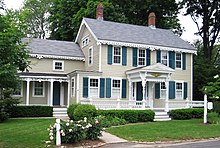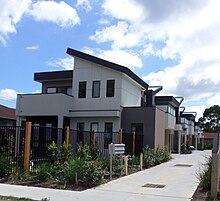Real estate is property consisting of land and the buildings on it, along with its natural resources such as crops, minerals or water; immovable property of this nature; an interest vested in this (also) an item of real property, (more generally) buildings or housing in general.[1][2]
Real estate is different from personal property, which is not permanently attached to the land, such as vehicles, boats, jewelry, furniture, tools and the rolling stock of a farm.
Residential real estate
Residential real estate may contain either a single family or multifamily structure that is available for occupation or for non-business purposes.[3]
Residences can be classified by and how they are connected to neighbouring residences and land. Different types of housing tenure can be used for the same physical type. For example, connected residences might be owned by a single entity and leased out, or owned separately with an agreement covering the relationship between units and common areas and concerns.[4]
- Major categories
- Attached / multi-unit dwellings
- Apartment (American English) or Flat (British English) – An individual unit in a multi-unit building. The boundaries of the apartment are generally defined by a perimeter of locked or lockable doors. Often seen in multi-story apartment buildings.
- Multi-family house – Often seen in multi-story detached buildings, where each floor is a separate apartment or unit.
- Terraced house (a. k. a. townhouse or rowhouse) – A number of single or multi-unit buildings in a continuous row with shared walls and no intervening space.
- Condominium (American English) – A building or complex, similar to apartments, owned by individuals. Common grounds and common areas within the complex are owned and shared jointly. In North America, there are townhouse or rowhouse style condominiums as well. The British equivalent is a block of flats.
- Cooperative (a. k. a. co-op) – A type of multiple ownership in which the residents of a multi-unit housing complex own shares in the cooperative corporation that owns the property, giving each resident the right to occupy a specific apartment or unit.
- Semi-detached dwellings
- Duplex – Two units with one shared wall.
- Detached dwellings
- Portable dwellings
- Mobile homes or residential caravans – A full-time residence that can be (although might not in practice be) movable on wheels.
- Houseboats – A floating home
- Tents – Usually temporary, with roof and walls consisting only of fabric-like material.
The size of an apartment or house can be described in square feet or meters. In the United States, this includes the area of "living space", excluding the garage and other non-living spaces. The "square meters" figure of a house in Europe may report the total area of the walls enclosing the home, thus including any attached garage and non-living spaces, which makes it important to inquire what kind of surface area definition has been used. It can be described more roughly by the number of rooms. A studio apartment has a single bedroom with no living room (possibly a separate kitchen). A one-bedroom apartment has a living or dining room separate from the bedroom. Two bedroom, three bedroom, and larger units are common. (A bedroom is a separate room intended for sleeping. It commonly contains a bed and, in newer dwelling units, a built-in closet for clothes storage.)
Other categories
The size of these is measured in Gaz (square yards), Quila, Marla, Beegha, and acre.
See List of house types for a complete listing of housing types and layouts, real estate trends for shifts in the market, and house or home for more general information.
As an investment
In markets where land and building prices are rising, real estate is often purchased as an investment, whether or not the owner intends to use the property. Often investment properties are rented out, but "flipping" involves quickly reselling a property, sometimes taking advantage of arbitrage or quickly rising value, and sometimes after repairs are made that substantially raise the value of the property.
Luxury real estate is sometimes used as a way to store value, especially by wealthy foreigners, without any particular attempt to rent it out. Some luxury units in London and New York City have been used as a way for corrupt foreign government officials and businesspeople from countries without strong rule of law to launder money or to protect it from seizure.[5]
See also
- Extraterrestrial real estate
- Real estate business
- Real estate economics
- Estate (land)
- Land lot
- Right to property
References
- ^ "Real estate": Oxford English Dictionary online: Retrieved September 18, 2011
- ^ James Chen (May 2, 2019). "What Is Real Estate?". investopedia.com. Retrieved May 13, 2019.
- ^ "Title 16. Conservation; Chapter 1. National Parks, Military Parks, Monuments, and Seashores; Minute Man National Historical Park". US Legal.
- ^ Kimberley Amadeo (March 28, 2019). "Real Estate, What It Is and How It Works". thebalance.com. Retrieved May 13, 2019.
- ^ "Why Manhattan's Skyscrapers Are Empty". The Atlantic. 16 Jan 2020.
Examples
Inner London, England
Gentrification is not a new phenomenon in Britain; in ancient Rome the shop-free forum was developed during the Roman Republican period, and in 2nd- and 3rd-century cities in Roman Britain there is evidence of small shops being replaced by large villas.[6] "London is being 'made over' by an urban centred middle class. In the post war era, upwardly mobile social classes tended to leave the city. Now, led by a new middle class, they are reconstructing much of inner London as a place both in which to work and live” (Butler, 1999, p. 77). King's College London academic Loretta Lees reported that much of Inner London was undergoing "super-gentrification", where "a new group of super-wealthy professionals, working in the City of London [i.e. the financial industry], is slowly imposing its mark on this Inner London housing market, in a way that differentiates it, and them, from traditional gentrifiers, and from the traditional urban upper classes ... Super-gentrification is quite different from the classical version of gentrification. It's of a higher economic order; you need a much higher salary and bonuses to live in Barnsbury" (some two miles north of central London).[105]
Barnsbury was built around 1820, as a middle-class neighbourhood, but after the Second World War (1939–1945), many people moved to the suburbs. The upper and middle classes were fleeing from the working class residents of London, made possible by the modern railway. At the war's end, the great housing demand rendered Barnsbury a place of cheap housing, where most people shared accommodation. In the late 1950s and early 1960s, people moving into the area had to finance house renovations with their money, because banks rarely financed loans for Barnsbury. Moreover, the rehabilitating spark was The 1959 Housing Purchase and Housing Act, investing £100 million to rehabilitating old properties and infrastructure. As a result, the principal population influx occurred between 1961 and 1975; the UK Census reports that "between the years of 1961 and 1981, owner-occupation increased from 7 to 19 per cent, furnished rentals declined from 14 to 7 per cent, and unfurnished rentals declined from 61 to 6 per cent";[106] another example of urban gentrification is the super-gentrification, in the 1990s, of the neighboring working-class London Borough of Islington, where Prime Minister Tony Blair lived until his election in 1997.[105] The conversion of older houses into flats emerged in the 1980s as developers saw the profits to be made. By the end of the 1980s, conversions were the single largest source of new dwellings in London.[107]
Mexico City
Mexico City has been an iconic example of an extensive metropolitan area since the 14th century when it became the largest city in the American continent. Its continuous population growth and concentration of economic and political power boomed in the 1930s when the country's involvement with global markets benefited the national financial industry. Currently the fifth largest city in the world, with a population of 21 million inhabitants (17.47% of national population) living in 16 districts and 59 municipalities, the urban area continues to expand receiving 1,100 new residents daily. The division of the city is derived from a strong socially and economically segregated population connected by its interdependence, that manifests into spatial arrangements where luxury areas coexist alongside slums. Its development around a core called “El Zocalo” derives from the historic, cultural and political relevance of a central plaza, as well as its contemporary concentration of economic power, currently housing 80% of all national firms.[108][109][110]
In recent years, a massive reconstruction and redesign of zones, motivated by both State and private investments, has created exciting areas of historic importance, entertainment opportunities and high quality residentials.[108] These urban developments have been catered to elite communities mainly because this group economically supports the country (38% of the total national income is produced by the top 10%) and because the government, predominantly lead by PRI (Partido Revolucionario Institucional), has maintained a profit-oriented policy perspective. Thus, these developments have not only led to an increase of population, traffic and pollution due to inefficient urban planning, but have also pushed great amounts of low-income families to the edges of the city and have challenged the safety of the 11.5 million people that economically depend on the underground sector.[111] This issue adds to the already critical condition of 40% of the population living in informal settlements, often without access to sewage network and clean water. The geology of the city, located in a mountain valley, further contributes to unhealthy living conditions, concentrating high levels of air pollution.[112]
The reality currently faced by the city is that of a historic rapid urban growth that has been unable to be adequately controlled and planned for, because of a corrupted and economically driven government, as well as a complex society that is strongly segregated. The negative effects of gentrification in Mexico City have been overlooked by the authorities, regarded as an inevitable process and argued to be in some cases nonexistent.[110] In recent years, however, an array of proposals have been developed as a way to continue the gentrification of the city in a way that integrates and respects the rights of all citizens.
Canada
By the 1970s, investors in Toronto started buying up city houses—turning them into temporary rooming houses to make rental income until the desired price in the housing market for selling off the properties was reached (so that the rooming houses could be replaced with high income-oriented new housing)—a gentrification process called "blockbusting."[113]
As of 2011, gentrification in Canada has proceeded quickly in older and denser cities such as Montreal, Toronto, Ottawa, Hamilton and Vancouver, but has barely begun in places such as Calgary, Edmonton, or Winnipeg, where suburban expansion is still the primary type of growth.
Canada's unique history and official multiculturalism policy has resulted in a different strain of gentrification than that of the United States. Some gentrification in Toronto has been sparked by the efforts of business improvement associations to market the ethnic communities in which they operate, such as in Corso Italia and Greektown.[114]
In Quebec City, the Saint Roch neighbourhood in the city's lower town was previously predominantly working class and had gone through a period of decline. However, since the early to mid 2000s, the area has seen the derelict buildings turned into condos and the opening of bars, restaurants and cafes, attracting young professionals into the area, but kicking out the residents from many generations back. Several software developers and gaming companies, such as Ubisoft and Beenox have also opened offices there.

